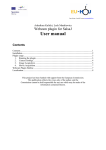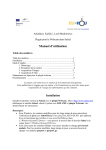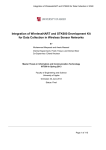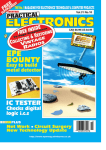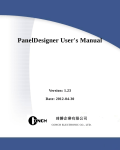Download PP18 v2.01 - User Manual
Transcript
PP18 – Programmer for PIC18 Softelec Free Electronic & Software Design PP18 v2.01 PIC18 Software Programmer User & Developer Guide 2003, October 20th – Rev 1.00 1 / 27 10/23/2003 PP18 – Programmer for PIC18 TO ANY PP18 USER Distribution: This file is part of PP18. PP18 is free software; you can redistribute it and/or modify it under the terms of the GNU General License as published by the Free Software Foundation; either version 2, or (at your option) any later version. PP18 is distributed in the hope that it will be useful, but WITHOUT ANY WARRANTY without even the implied warranty of MERCHANTABILITY or FITNESS FOR A PARTICULAR PURPOSE. See the GNU General Public License for more details. You should have received a copy of the GNU General Public License along with PP18; see the file COPYING.txt. If not, write to the Free Software Foundation, 59 Temple Place - Suite 330, Boston, MA 02111-1307, USA. 2 / 27 10/23/2003 PP18 – Programmer for PIC18 Table of content 1 APPLICATION OVERVIEW........................................................................................................................... 5 1.1 1.2 1.3 1.4 1.5 2 PRESENTATION ................................................................................................................................................. 5 CURRENT RELEASE ........................................................................................................................................... 5 SUPPORTED DEVICES ........................................................................................................................................ 5 SUPPORTED PROGRAMMERS ............................................................................................................................. 5 PERFORMANCE ................................................................................................................................................. 6 INSTALLATION PROCEDURE ..................................................................................................................... 7 2.1 2.2 2.3 2.4 2.5 3 MINIMUM CONFIGURATION .............................................................................................................................. 7 ZIP FILE CONTENT ............................................................................................................................................ 7 W95 / W98 INSTALLATION............................................................................................................................... 7 W2000/ NT / XP INSTALLATION ...................................................................................................................... 7 WINDOWS REGISTRY ........................................................................................................................................ 7 PP18 USER GUIDE ........................................................................................................................................... 8 3.1 3.2 3.3 3.4 3.5 3.6 3.7 3.8 3.9 3.10 3.11 3.12 3.13 3.14 3.15 4 SELECT DLL..................................................................................................................................................... 8 ABOUT THE DLL .............................................................................................................................................. 8 DOWNLOAD FROM PIC ..................................................................................................................................... 8 OPEN AN HEX FILE .......................................................................................................................................... 9 SAVE AN HEX FILE AS...................................................................................................................................... 9 SELECT THE CURRENT DISPLAY ........................................................................................................................ 9 UPLOAD TO PIC................................................................................................................................................ 9 POPUP MENU ..................................................................................................................................................... 9 HARDWARE SETTINGS .................................................................................................................................... 10 ADVANCED SETTINGS ................................................................................................................................ 10 CONFIGURATION BITS ................................................................................................................................ 11 SELECT PLUG-IN......................................................................................................................................... 11 BULK ERASE .............................................................................................................................................. 11 PIC AUTODETECTION................................................................................................................................. 11 ABOUT THE APPLICATION .......................................................................................................................... 11 DEVICE MIGRATION ................................................................................................................................... 12 4.1 4.2 4.3 4.4 4.5 5 REQUIREMENTS .............................................................................................................................................. 12 DLL ARCHITECTURE OVERVIEW..................................................................................................................... 12 DLL INTERFACE ............................................................................................................................................. 12 CUSTOMISING DLL ........................................................................................................................................ 12 VALIDATION TEST PLAN ................................................................................................................................. 12 HARDWARE MIGRATION........................................................................................................................... 13 5.1 5.2 6 CUSTOMISING HARDWARE .............................................................................................................................. 13 DEVELOPING WITH A NEW PERIPHERAL .......................................................................................................... 13 TROUBLESHOOTING................................................................................................................................... 14 6.1 6.2 6.3 HARDWARE NOT DETECTED ............................................................................................................................ 14 PIC NOT DETECTED ........................................................................................................................................ 14 PIC18 IS BAD PROGRAMMED .......................................................................................................................... 15 7 REVISION HISTORY ..................................................................................................................................... 16 8 RELATED DOCUMENTATIONS................................................................................................................. 17 3 / 27 10/23/2003 PP18 – Programmer for PIC18 9 CONTACTS AND MAINTAINERS............................................................................................................... 18 10 APPENDICES .................................................................................................................................................. 19 10.1 10.2 10.3 4 / 27 INTERFACE BETWEEN PP18 AND DLL ....................................................................................................... 19 FIRST ACCESS TO THE CHIP INSERTED (EXAMPLE FOR PIC18F458)............................................................ 24 EXAMPLE TO PROGRAM A PIC18FXXX DEVICE .......................................................................................... 25 10/23/2003 PP18 – Programmer for PIC18 1 APPLICATION OVERVIEW 1.1 Presentation PP18 is freeware, which programs any PIC in the Microchip PIC18 family. It is distributed under GPL licence. PP18 offers a Graphical User Interface to access the PIC18 memory easily. The application is separated in 2 parts: ! A window common to every PIC18 managed by the application. ! A specific DLL (Dynamic Loaded Library) for each PIC in the PIC18 family. PP18 is running properly under any 32-bit version of Microsoft Windows. PP18 should be ported to Linux, but this release does not yet run under “Unix like” operating systems. 1.2 Current release The current release is the 2.01. The previous version (1.00) of PP18 was not able to program any PIC18, but just PIC18F452 chip. The 1.00 version has validated the PIC18 access through a parallel port. The release 2.00 is based on an interface in-between the main window and the DLL in order to manage each PIC18 specifically. Indeed Microchip does not use the same access protocol for every PIC in the PIC18 family. 1.3 Supported devices The devices supported by the PP18 release 2.00 are: PIC18F242 PIC18F248 PIC18F442 PIC18F448 PIC18F252 PIC18F258 PIC18F452 PIC18F458 PIC18F1220 PIC18F1320 PIC18F2220 PIC18F2320 PIC18F2331 PIC18F2431 5 / 27 Available YES YES YES YES YES YES YES YES NO YES NO NO NO NO Tested YES NO YES NO YES NO YES YES NO YES NO NO NO NO PIC18F4220 PIC18F4320 PIC18F4331 PIC18F4431 PIC18F6520 PIC18F6620 PIC18F6720 PIC18F6680 PIC18F8520 PIC18F8620 PIC18F8720 PIC18F8680 YES NO NO NO YES YES YES NO NO NO YES NO YES NO NO NO NO YES YES NO NO NO NO NO PIC18C242 JW/OTP PIC18C248 JW/OTP PIC18C442 JW/OTP PIC18C448 JW/OTP PIC18C252 JW/OTP PIC18C258 JW/OTP PIC18C452 JW/OTP PIC18C458 JW/OTP PIC18C1220 JW/OTP PIC18C1320 JW/OTP PIC18C2220 JW/OTP PIC18C2320 JW/OTP PIC18C2331 JW/OTP PIC18C2431 JW/OTP PIC18C4220 JW/OTP PIC18C4320 JW/OTP PIC18C4331 JW/OTP PIC18C4431 JW/OTP PIC18C6520 JW/OTP PIC18C6620 JW/OTP PIC18C6720 JW/OTP PIC18C6680 JW/OTP PIC18C8520 JW/OTP PIC18C8620 JW/OTP PIC18C8720 JW/OTP PIC18C8680 JW/OTP NO NO NO NO NO NO NO NO NO NO NO NO NO NO NO NO NO NO NO NO NO NO NO NO NO NO NO NO NO NO NO NO NO NO NO NO NO NO NO NO NO NO NO NO NO NO NO NO NO NO NO NO For each PIC18 supported there is a specific DLL located on the web site of PP18. The DLL filename is the one of the device. 1.4 Supported programmers PP18 is designed to access PIC18 through any peripheral because this job is done by the DLL. Elsewhere the PIC18 device needs only 5 signals to be programmed: ! VCC ! VPP ! DATA TO PIC 10/23/2003 PP18 – Programmer for PIC18 ! ! DATA FROM PIC CLOCK It is recommended to use SCHAER and SCHAER+ programmers through LPT port. All the free DLL proposed with PP18 have to be used with SCHAER type programmer. The SCHAER+ programmer is a hardware derived from the famous SCHAER programmer designed to access the PIC16F84 through the parallel port. The SCHAER+ version is able to manage the 5 signals described above. It exists in a version with ZIF 40 pins socket to program PDIP chips and an ICSP version to program the chip from the PCB itself. Visit the following web site to get more information related to SCHAER+ programmer: http://perso.wanadoo.fr/softelec 1.5 Performance PP18 is really fast software, capable of programming the entire memory (code, configuration bits and ID), reading all the fields programmed and computing the corresponding checksum in less than 10 seconds in case of maximum speed settings (32 Kb target). To do so PP18 uses a DIRECT IO method to address the LPT port of the PC. The application accesses directly the IO address even on protected Windows platforms, thanks to ALLOWIO.exe program from www.beyondlogic.org. 6 / 27 10/23/2003 PP18 – Programmer for PIC18 2 INSTALLATION PROCEDURE Every time you run PP18 the application will look up the key to take into account the last settings. 2.1 Minimum configuration Because Windows 2000, NT or XP need kernel privileges to access directly the IO addresses, PP18 is not authorized to write and read through the LPT port (PP18 is running with application privileges). The minimum configuration required is an i386 processor with 8 Mbytes of memory, and Microsoft Windows. Tests have been done with a Intel Celeron processor at 400 MHz with 128 Mbytes of RAM. Windows 98 and Borland Builder 3.0 have been chosen for validation and development. 2.2 ZIP file content Here is a screenshot of the ZIP file content: 2.4 W2000/ NT / XP installation So it’s necessary to use a kind of bridge to allow an application to access a resource via the bridge. This is the job of a driver. To get the same effect without developing any driver, we can use ALLOWIO.exe program developed by www.beyondlogic.org. To execute PP18 under Windows 2000, NT or XP open a DOS window and find the directory where PP18_v2_00.zip has been extracted. Type “Allowio 0x378 PP18.exe” which permits PP18 to freely access the LPT 1 (0x378), and then runs PP18. For a more comfortable use create a batch file in which you’ll insert the previous command line. 2.5 Windows Registry All the PP18 settings are stored in the Registry in order to facilitate the reuse of the application. The key manipulated by PP18 is located at: HKEY_CURRENT_USER/Software/PP18 To not disturb PP18 process it is mandatory to not modify the values of this key. You can read or copy the content of the key, but never change it. 2.3 W95 / W98 installation To run PP18 under Windows 95 or 98 you don’t need any special installation. In case any value has been changed, terminate the PP18 application, delete the entire PP18 key from the Registry and launch PP18. This will generate a new PP18 key. At the first run, the application will look up the register of Windows to create a new key. This key contains all the settings of PP18: ! Path for HEX file ! Path for DLL ! Current release of PP18 ! DelayIO value ! Settings of the programmer 7 / 27 10/23/2003 PP18 – Programmer for PIC18 3 PP18 USER GUIDE We suppose you have correctly installed PP18 on your Windows platform. PP18 runs as a single window, non sizeable with just the EXIT button enabled. 3.1 Select DLL By putting the mouse above the ZIF image (Zero Insertion Force) at the right side of the window, the icon should change to a hand. Right click to display a POPUP menu, and choose the SELECT PLUG-IN item. Click on the OK button to accept the DLL. If you want to change to a different DLL, close the window by clicking on the OK button, then select another DLL from the ZIF image of the main window. This DLL expects to find this chip on the hardware programmer and then will try to make an automatic detection of this device. Navigate through the window opened to find the directory where the PIC18 specific DLLs are located. Then select the DLL corresponding to the device you have inserted into the programmer. The hardware detection result is displayed in the right-hand side of status bar and the DLL filename loaded is displayed at the left side of the status bar. 3.3 Download from PIC If you have inserted a blanked PIC18 into the hardware programmer, you should get a new image at the ZIF location: the image depicts a generic PIC18Fxxx device inserted into the ZIF. The picture is generic means it does not look exactly the same as the PIC18 itself. Only the DLL is able to show a representative view of the PIC18 manipulated. 3.2 About the DLL If the selected DLL interface is recognized by the main application a new modal windows appears showing a picture and the name of the PIC18 managed by the DLL. 8 / 27 10/23/2003 PP18 – Programmer for PIC18 Now that the PIC18F of your choice has been detected by the DLL, the DOWNLOAD and LOAD buttons are enabled. Furthermore all the data related to this selection (memory + configuration bits + ID) are taken into account by the application. Click on the DOWNLOAD button to read the content (Memory + configuration bits + ID) of the PIC18. If your device is really blanked (each memory byte is equal to 0xFFFF), then a message box appears telling you the PIC18 is blanked. 3.7 Upload to PIC 3.4 Open an HEX file Click on the LOAD button to open a modal selection file window. Select an HEX file such as those generated by Microchip MPLAB. Now that the central grid is filled with the content of the PIC18 memory or the content of an HEX file, all of the buttons located at the left-hand side of the application are enabled. It is also possible to upload the data displayed in the grid (you can chose the source of this content by selecting the appropriate item in the combo box). The upload action starts with a non-visible BULK ERASE operation to set the PIC18 into this state: ! All code memory set to 0xFFFF ! Configuration bits set to default values (cf Microchip program specifications) ! ID values are set to 0xFF Then the upload action proceeds to a WRITE, VERIFY and READ operation, then displays a message to tell you if the upload operation succeeded: A new content is displayed in the central grid without deleting the previous content from the PIC18 inserted. To switch from PIC to FILE view you have to use the CURRENT DISPLAY combo box. 3.5 Save an HEX file as Click on the SAVE button to convert all the data (memory + configuration bits + ID) specified by the CURRENT DISPLAY combo box into an HEX file. All the code memory is stored in the destination file, even if the code contains only 0xFFFF values. 3.6 Select the current display The CURRENT DISPLAY combo box allows you to change the content of the central grid to the one from either the PIC or the FILE. 9 / 27 3.8 Popup menu The popup menu above the ZIF picture gives you more access to the DLL’s functionality: ! HW settings ! Configuration bits ! Select plug-in ! Bulk erase ! Autodetect PIC ! About 10/23/2003 PP18 – Programmer for PIC18 inverts the signal, so we need to take into account this inversion to properly drive the signal from the panel. Note: Always configure the status of every signal so that you get a physical “1” on the PIC18 (can be read with a voltmeter). 3.10 Advanced settings All these actions are described in the next paragraphs. 3.9 Hardware settings The advanced settings window is for people who want to adapt or build a new hardware programmer. The tested programmer must manage the 5 signals introduced above. The settings window offers the ability to setup the hardware but also to test if it is properly connected. With a SCHAER+ programmer, click on the DATA TO PIC button to send a bit signal to the programmer. Because of a hardware loop located on the programmer printed circuit, you should see the DATA FROM PIC lighted. The OFF state of any button means the signal is logically at 0 and not physically at 0 in the LPT port. To do so we add a status parameter with 2 possible values: ! INVERTED ! NOT INVERTED Thanks to the combination of status we are able to read on the programmer the state displayed on the button. Example: Click on the VPP button. The VPP light on the SCHAER+ board switches ON. Click on the NOT INVERTED VPP status. The light switches OFF. It means a transistor on the programmer probably 10 / 27 The combo boxes permit the user to change the MASK value of each signal. This MASK translates a signal to a bit of the data or command registers of the LPT port. The LPT port number selection is there to specify another LPT address if required. The Delay_Prog parameter creates a latency time between the WRITE commands sent to the programmer. For 40 pins PIC18 programming a Delay_Prog equal to 10% is sometimes enough. For 28 pins device set a Delay_Prog equal to 40% is necessary. This parameter is tuned automatically by the DLL during the WRITE operation. Set it to 0 to let PP18 find the best value. The Delay_IO is computed automatically by clicking on the Auto-setup button. That force the DLL to find the small latency necessary to communicate with the chip properly. 10/23/2003 PP18 – Programmer for PIC18 3.11 Configuration bits This window shows you all the configurable bits located in the PIC18 at the addresses beginning at 0x300000. The BULK ERASE action is followed by a DOWNLOAD action to check if the chip is really erased or not. So after erasing the PIC18 you have to obtain the window: Click on the OK button to close the message box and continue your job. 3.14 PIC autodetection The check boxes are used to enable or disable some configuration bits and the combo boxes are used to select the appropriate configuration. By default the application is scanning the programmer every 500 ms to detect the presence of the PIC18 specified by the DLL. If the expected PIC18 is inserted into the programmer the application displays a ZIF with a generic PIC18Fxxx chip on it: You may notice that every time you load a new HEX file you have to setup the configuration bits once more. To avoid this click on the locker button. It freezes all the configuration bits so that you can update your PIC18 faster by just loading a file and uploading it to the PIC without any configuration setup. About CODE PROTECTION: Not all the possible configurations are represented here. For instance, if you want to lock the boot block AND the 4th panel in memory, you have to lock all the memory. 3.12 Select plug-in Click on the AUTODETECT PIC item to disable it. Click again to re-enable it. 3.15 About the application The ABOUT item displays the splash screen of the application. It is the only item to be dependant on the main application, not of the DLL. Described at the beginning of the chapter. 3.13 Bulk erase The BULK ERASE operation sets the PIC18 into this state: ! All code memory set to 0xFFFF ! Configuration bits set to default (cf Microchip program specifications) 11 / 27 10/23/2003 PP18 – Programmer for PIC18 4 Device migration This chapter describes how to proceed to port the DLL sources in order to program other chips (PIC18, PIC16, etc). 4.1 Requirements The DLL sources are included in the ZIP file of the PP18 sources. The related project is a Borland Builder 5.0 project. Open the “PIC18F452.bpr” to view all the sources attached to the project. You are not forced to develop with Borland Builder IDE just because PP18 expects a Windows DLL. You can develop of course with Microsoft Visual Studio IDE provided that you respect the interface between PP18 and the DLL (file DLL_interface.c). The content of the interface is presented in the Appendix A “Interface in-between PP18 and DLL”. You have to respect this interface to be sure PP18 will be able to respond to all the actions of the user. The DLL is responsible for detecting the presence of the PIC18 on the hardware programmer. This is done through the ReadRevDev function by sending a request periodically to read the REV or DEV field of the PIC inserted. Have a look at the Appendix B. 4.4 Customising DLL The core of the DLL itself is split into 2 parts: • Com.c: this file contains all the code related to the HEX parser, the procedures to read or write the PIC18 and some additional functions to initialise or test the hardware. • Driver.c: this file contains all the very low level code to program or read the different parts of the PIC18 memories. It is includes the definitions of both of the Macros describing the way the data are sent to the LPT port. 4.2 DLL architecture overview The DLL sources included in the PP18 sources are related to the PIC18F452 Microchip device. The Borland Builder project includes the following files: PIC18F452.bpr PIC18F452.res P18F452.cpp DLL_interface.c DLL_interface.h Com.c Com.h Driver.c Driver.h DLLAbout.cpp DLLAbout.h DLLAbout.dfm Settings.cpp Settings.h Settings.dfm Configuration.cpp Configuration.h Configuration.dfm Advanced.cpp Advanced.h Advanced.dfm Builder project Resources file DLL entry function Interface function list Interface header file Manage data from FILE or PIC Com header file Programmer driver Programmer driver header file Show the “About” window “About” window header file Specific B. Builder file Show the “Settings” window “Settings” window header file Specific B. Builder file Show the “Config” window “Config” window header file Specific B. Builder file Show the “Advanced” window “Advanced” window header file Specific B. Builder file So to port the DLL to a new PIC architecture like PIC16 for instance, you have to adapt the code of Driver.c file to respect the Microchip specifications. These specifications are regrouped in a specific document as nominated in the Documentation chapter. Have a look at the Appendix C “Example to program a PIC18Fxxx device” and the Microchip programming specifications to understand better how to write your code. 4.5 Validation test plan At the end of the Microchip programming specifications, you can find an example of checksum computation for typical content of memories (code + configuration bits + ID). First check that you always find what is indicated by Microchip, and then try to drive your hardware signal by signal. Finally you’re ready to access the chip. 4.3 DLL interface The interface with the main application is described in the DLL_interface.h file. 12 / 27 10/23/2003 PP18 – Programmer for PIC18 5 Hardware migration This chapter describes how to setup PP18 to use another kind of programmer (SCHAER, JDM, etc). 5.1 Customising hardware PP18 has been designed to communicate with a PIC18 device via 5 signals: ! ! ! ! ! MCLR /VPP: enable access to the chip VCC: power on/off the chip DATA TO PIC: send a bit to the chip DATA FROM PIC: read a bit from the chip CLOCK: enable read/write of each bit These 5 signals are mandatory by Microchip ICSP programming specification. PP18 manages these 5 signals through the parallel port (LPT). The “DATA FROM PIC” signal is a bit from the command register of the LPT port, the other signals are bits of the data register of LPT port. If you’re used to programming your chip with another programmer than a SCHAER type one, then it is possible to customize the position of these signals in the LPT registers. You can easily do it from the ADVANCED window of the DLL: are not possible on a LPT port (2 signals are using the same value for instance), a message box will appear. Take care to choose a correct value for every signal. Only the “DATA FROM PIC” signal is an input (PC view), the others are outputs. If you setup wrong values, the chip won’t be detected (the ZIF image remains empty). 5.2 Developing with a new peripheral If you want to access the hardware through a different hardware interface than the LPT port, so you have to modify both of the Macros dedicated to the transfer to the LPT port. The details of the code are presented in Appendix D “MACRO definitions to access LPT port”. Of course if you want to use a block oriented peripheral like USB you’ll have to rebuild the entire Driver.c file. Indeed the actual file is dedicated to character-oriented device (LPT port)… An interface like USB would greatly increase the global performance of the data transfer and also would allow programming the PIC18 under 5V only, without any external power supply, just by using the 5V provided by the USB connection. This panel allows the user to setup the LPT port, but doesn’t provide a way to modify the transfer protocol or to change of COM type (serial, USB, fibre, etc). Click on the OK button to validate your new settings or the CANCEL button to abort. If the new settings 13 / 27 10/23/2003 PP18 – Programmer for PIC18 6 Troubleshooting ! ! This chapter presents all the troubles you can encounter using PP18 with SCHAER+ or your own hardware, and also how to solve them. ! check the LPT cable check you LPT port address is correct (open the Advanced Settings window) check the signal on the LPT connector itself (to find any hardware problem…) The first step to program a PIC18 with PP18 is to correctly detect the programmer itself. To detect the hardware PP18 just uses the data loop on the 7407 chip. It sends a logical “1” on “Data to PIC” and expect a logical “1” on the “Data from PIC” signal. If you don’t succeed to detect any hardware you should have: When you solve the hardware problem you should have an “HW detected” in the status bar of PP18: Open the hardware settings windows to test your hardware: 6.2 PIC not detected 6.1 Hardware not detected Every 500 ms PP18 try to detect the presence of any PIC18 inserted in the programmer. To do so it sends a request to the hardware in order to read the REV / DEV fields of configuration bits. If the result is all bits at “1” then there is no chip inserted. If a value is detected it is compared to the one expected by the DLL. Only the expected PIC18 will be recognised by the DLL. If the chip is not detected by PP18 the DOWNLOAD and UPLOAD buttons are disabled: Click on the “Data to PIC” button and check you have physically a “1” at the dedicated PIC18 pin (RB7 for instance). Once you find a “1” on your board, check the colour of the “Data from PIC” button. It shows if the hardware is detected or not by the PP18 software. If it’s RED the hardware is detected, if not change the “Inverted / Not Inverted” property. If you’re failed verify the following points: ! ! check the hardware is powered on click on the “Inverted / Not inverted” radio buttons to invert the signal if necessary 14 / 27 Check first you’re using the DLL dedicated to your PIC18 ! If you’re using the appropriate DLL then check the VPP led (the closest of the ZIF socket on SCHAER+ programmer) is blinking twice per second. Then check the CLOCK and VCC signals from the SETTINGS window in order to be sure the correct tension is applied on your PIC18. 10/23/2003 PP18 – Programmer for PIC18 Now we suppose the hardware settings are correct (use Settings window). If the device is still not detected then you should open the Advanced Settings window to tune the communication transfer rate. To detect the PIC18 properly the Delay_IO parameter is not involved. In fact it’s only used to write data into the flash correctly. Click now on the AUTO-SETUP button to let PP18 find the best Delay_Prog parameter for your computer. This parameter is a delay inserted in every CLOCK change to let the PIC18 enough time to understand the requests. This means PP18 succeeds to communicate with the PIC18 inserted but when it verifies the content of the written memory the check action failed. With the 2.01 version of PP18 you don’t have to modify the Delay_Prog parameter. This value lets more time to the chip to write data into the flash memory. An automatic retry is forced by the PP18 DLL in order to tune the best Delay_Prog for your hardware and your PIC18. Then if the transfer failed your chip is probably dead. Try with another chip and you should have this message: To speed up the PP18 transfer to the chip change the resistor connected to the DATA pin of the PIC18 in your programmer. The smaller is the resistor the faster is the transfer to the PIC18. Value less than 1 Kohm may not be used in a SCHAER+ like programmer. PP18 should find the PIC18 inserted and the smallest Delay_IO value to speed up the transfer to the chip. If PP18 does not succeed to find any chip, check your hardware (GND signal connected to the LPT connector, any hardware shortcuts, PIC18 socket,…). 6.3 PIC18 is bad programmed After programming the device you can get a such message: 15 / 27 10/23/2003 PP18 – Programmer for PIC18 7 Revision history Rev 1.00 - Spetember 2003 : Initial release. 16 / 27 10/23/2003 PP18 – Programmer for PIC18 8 Related documentations " Programming for PIC18Fxx2/PIC18Fxx8 Flash MCUs Ref: DS39576A " Programming for PIC18Fx220/PIC18Fx320 Flash MCUs Ref: DS39592B " PIC18Fxx2 Data Sheet Ref: DS39564A 17 / 27 10/23/2003 PP18 – Programmer for PIC18 9 Contacts and maintainers For any question concerning PP18 or SCHAER+ programmers you can contact the following persons: " Xavier MONTAGNE [email protected] 18 / 27 10/23/2003 PP18 – Programmer for PIC18 10 Appendices 10.1 Interface between PP18 and DLL /**********************************************************************/ /* */ /* File name: DLL_interface.h */ /* */ /* Since: 2002/12/03 */ /* */ /* Version: 1.0 */ /* */ /* Author: MONTAGNE Xavier [XM] {link [email protected]} */ /* */ /* Purpose: Offer high level interface for PIC programming operations:*/ /* parsing or creat an HEX file, updating the PIC structures */ /* after parsing, reading or programming the PIC,... */ /* */ /* Distribution: This file is part of PP18. */ /* PP18 is free software; you can redistribute it */ /* and/or modify it under the terms of the GNU General */ /* Public License as published by the Free Software */ /* Foundation; either version 2, or (at your option) */ /* any later version. */ /* */ /* PP18 is distributed in the hope that it will be */ /* useful, but WITHOUT ANY WARRANTY; without even the */ /* implied warranty of MERCHANTABILITY or FITNESS FOR A */ /* PARTICULAR PURPOSE. See the GNU General Public */ /* License for more details. */ /* */ /* You should have received a copy of the GNU General */ /* Public License along with PP18; see the file */ /* COPYING.txt. If not, write to the Free Software */ /* Foundation, 59 Temple Place - Suite 330, */ /* Boston, MA 02111-1307, USA. */ /* */ /* History: */ /* 2002/12/03 [XM] Create this file */ /* */ /**********************************************************************/ #if !defined(__DLL_INTERFACE_H__) #define __DLL_INTERFACE_H__ /*********************************************************************** * INCLUDES **********************************************************************/ #include <windows.h> #include "com.h" /*********************************************************************** * DEFINES **********************************************************************/ #define FromPIC 1 #define FromFile 0 #define DLL_EXPORT __declspec(dllexport) /*********************************************************************** 19 / 27 10/23/2003 PP18 – Programmer for PIC18 * FUNCTION DEFINITIONS **********************************************************************/ #if defined(__cplusplus) extern "C" { #endif /*********************************************************************** * Only fill the SHexFile structure. Do not proceed to any programming * sequences. This function fills the Hex_from_file structure, so it has * to be called first to initialyze. * * @param char *ucFilename IN HEX filename to parse * @return Status_t FILE_ERROR if something wrong appends * (Hex larger than PIC memory size) * ALL_RIGHT otherwise **********************************************************************/ Status_t DLL_EXPORT ParseFile(char *ucFilename); /*********************************************************************** * Give the memory size of the chip (and not the memory size of usefull * data inside the PIC), or the data size of the HEX file parsed. * * @param u_int *uiSize OUT PIC memory size * @param u_int uiFrom IN Flag (PIC or File) * @return Status_t Always ALL_RIGHT **********************************************************************/ Status_t DLL_EXPORT GetMemorySize(unsigned int *uiSize, unsigned int uiFrom); /*********************************************************************** * Copy the memory content from the PIC or FILE structure to the buffer * parameter. * * @param u_short *usMemory OUT Memory buffer * @param u_int uiFrom IN Flag (PIC or File) * @return Status_t Always ALL_RIGHT **********************************************************************/ Status_t DLL_EXPORT GetMemoryBuffer(unsigned short *usMemory, unsigned int uiFrom); /*********************************************************************** * Copy the memory content from the buffer to the PIC or FILE structure. * * @param u_short *usMemory IN Memory buffer * @param u_int uiFrom IN Flag (PIC or File) * @return Status_t Always ALL_RIGHT **********************************************************************/ Status_t DLL_EXPORT SetMemoryBuffer(unsigned short *usMemory, unsigned int uiFrom); /*********************************************************************** * Rebuil a HEX File from memory, config and ID. Do not proceed to any * programming sequences. This function creats a new HEX file a replace * an existing one. * * @param char *ucFilename IN HEX filename to build * @param u_int uiFrom IN Flag (PIC or File) * @return Status_t FILE_ERROR if something wrong appends * (cannot creat a new file) * ALL_RIGHT otherwise **********************************************************************/ Status_t DLL_EXPORT UnParseFile(char *ucFilename, unsigned int uiFrom); /*********************************************************************** * Perform a programmation process to the hardware programmer and the 20 / 27 10/23/2003 PP18 – Programmer for PIC18 * chip on it concerning memory area only. * * @param u_int uiFrom IN Flag (PIC or File) * @return Status_t BAD_PROGRAMMED if something wrong appends * PROGRAMMED if not * ALL_RIGHT otherwise **********************************************************************/ Status_t DLL_EXPORT ProgramMem(unsigned int uiFrom); /*********************************************************************** * Perform a programmation process to the hardware programmer and the * chip on it concerning config area only. * * @param u_int uiFrom IN Flag (PIC or File) * @return Status_t BAD_PROGRAMMED if something wrong appends * PROGRAMMED if not * ALL_RIGHT otherwise **********************************************************************/ Status_t DLL_EXPORT ProgramConfig(unsigned int uiFrom); /*********************************************************************** * Perform a programmation process to the hardware programmer and the * chip on it concerning ID area only. * * @param u_int uiFrom IN Flag (PIC or File) * @return Status_t BAD_PROGRAMMED if something wrong appends * PROGRAMMED if not * ALL_RIGHT otherwise **********************************************************************/ Status_t DLL_EXPORT ProgramID(unsigned int uiFrom); /*********************************************************************** * Download the code memory field from the PIC device, and update the * PIC structure. * * @param void * @return Status_t BLANK if all memory set to 0xFFFF * NOT_BLANK if not * ALL_RIGHT otherwise **********************************************************************/ Status_t DLL_EXPORT ReadMem(void); /*********************************************************************** * Download the config field from the PIC device, and update the PIC * structure. * * @param void * @return Status_t LOCKED if Code Prection ON * ALL_RIGHT otherwise **********************************************************************/ Status_t DLL_EXPORT ReadConfig(void); /*********************************************************************** * Download the ID field from the PIC device, and update the PIC * structure. * * @param void * @return Status_t Always ALL_RIGHT **********************************************************************/ Status_t DLL_EXPORT ReadID(void); /*********************************************************************** * Download REV+DEV from the chip present in the device chip. 21 / 27 10/23/2003 PP18 – Programmer for PIC18 * This function fills the Hex_from_file structure, so it has * to be called first to initialyze the PIC structure. * * @param char *PICname IN PIC name reference (name of DLL) * @return Status_t PIC_DETECTED if right PIC detected * HARDWARE_ERROR if not detected **********************************************************************/ Status_t DLL_EXPORT ReadRevDev(char *PICname); /*********************************************************************** * Get the ID field of the structure specify by uiFrom with the ucValue. * The field is 8 bytes long, so just the byte specified by ucIndex is * modified. * * @param u_char *ucValue IN Value of the ID to get at ucIndex pos * @param u_char ucIndex IN Index of the ID to get * @param u_int uiFrom IN Flag (PIC or File) * @return Status_t Always ALL_RIGHT **********************************************************************/ Status_t DLL_EXPORT GetIDValue(unsigned char *ucValue, unsigned char ucIndex, unsigned int uiFrom); /*********************************************************************** * Fill the ID field of the structure specify by uiFrom with the ucValue. * The field is 8 bytes long, so just the byte specified by ucIndex is * modified. * * @param u_char ucValue IN Value of the ID to set at ucIndex pos * @param u_char ucIndex IN Index of the ID to set * @param u_int uiFrom IN Flag (PIC or File) * @return Status_t Always ALL_RIGHT **********************************************************************/ Status_t DLL_EXPORT SetIDValue(unsigned char ucValue, unsigned char ucIndex, unsigned int uiFrom); /*********************************************************************** * Extract the checksum info from every line of an INTEL HEX file. * Compare it with the value computed by the HEX parser. * * @param u_short *usChecksum IN Reference to the checksum computed * @param u_int uiFrom IN Flag (PIC or File) * @return Status_t Always ALL_RIGHT **********************************************************************/ Status_t DLL_EXPORT ComputeGeneralChecksum(unsigned short *usChecksum, unsigned int uiFrom); /*********************************************************************** * Check the presence of a programmer on LPT port. * Hardware present if DATA_FROM_PIC == DATA_TO_PIC[0 or 1] * * @param void * @return Status_t ALL_RIGHT if hardware present * HARDWARE_ERROR if not present **********************************************************************/ Status_t DLL_EXPORT IsHWPresent(void); /*********************************************************************** * Stuck at 0 all of the signals (logical 0, not necessarily physical 0). * * @param void * @return Status_t Always ALL_RIGHT **********************************************************************/ Status_t DLL_EXPORT InitHardware(void); 22 / 27 10/23/2003 PP18 – Programmer for PIC18 /*********************************************************************** * Stuck at 1 the VCC signal (logical 1, not necessarily physical 1). * * @param void * @return Status_t Always ALL_RIGHT **********************************************************************/ Status_t DLL_EXPORT PowerOn(void); /*********************************************************************** * Stuck at 0 the VCC signal (logical 0, not necessarily physical 0). * * @param void * @return Status_t Always ALL_RIGHT **********************************************************************/ Status_t DLL_EXPORT PowerOff(void); /*********************************************************************** * About window of the DLL. * Catch the HWND handle of the application. * * @param HWND hWnd IN Handle of the main window * @return Status_t Always ALL_RIGHT **********************************************************************/ Status_t DLL_EXPORT ShowDLL(HWND hWnd); /*********************************************************************** * Show Settings window. * * @param HWND hWnd IN Handle of the main window * @return Status_t Always ALL_RIGHT **********************************************************************/ Status_t DLL_EXPORT ShowSettings(HWND hWnd); /*********************************************************************** * Display the "Config" window of the DLL. * * @param HWND hWnd IN Handle of the main window * @return Status_t Always ALL_RIGHT **********************************************************************/ Status_t DLL_EXPORT ShowConfig(HWND hWnd, unsigned int uiFrom); /*********************************************************************** * Erase all the programmable bits of the PIC18. * * @param HWND hWnd IN Handle of the main window * @return Status_t Always ALL_RIGHT **********************************************************************/ Status_t DLL_EXPORT DoBulkErase(HWND hWnd); #if defined(__cplusplus) } #endif #endif /* __DLL_INTERFACE_H__ */ /* End of File */ 23 / 27 10/23/2003 PP18 – Programmer for PIC18 10.2 First access to the chip inserted (example for PIC18F458) /*********************************************************************** * Download REV+DEV from the chip present in the device chip. * This function fills the Hex_from_file structure, so it has * to be called first to initialyze the PIC structure. * * @param char *PICname IN PIC name reference (name of DLL) * @return Status_t PIC_DETECTED if right PIC detected * HARDWARE_ERROR if not detected **********************************************************************/ Status_t DLL_EXPORT ReadRevDev(char *PICname) { pHexFile_t p_hfFile; pStatistic_t p_Stat; unsigned short usWord, usRev, usDev; static unsigned int uiDetected = 0; char thePICname[10] = "PIC18F458"; p_hfFile = &HEX_from_PIC; p_Stat = &Stat; p_hfFile->SChipStatus = 0; ReadBlock(0x3FFFFE, &usWord, 1); usRev = usWord & 0x1F; usDev = ((usWord & 0xE0) >> 5) + ((usWord & 0xFF00) >> 5); if (usRev == 0x1F) p_hfFile->SChipStatus = 8; if ((usDev & 0x07FF) == 0x43) { p_hfFile->SChipStatus = 7; if (uiDetected == 0) { p_hfFile->pusMemory = &MemPIC[0]; p_hfFile->pConfig = &CFG_PIC; p_hfFile->uiMemorySize = _MAX_PIC_SIZE; memset(p_hfFile->pusMemory, 0xFF, p_hfFile->uiMemorySize * sizeof(unsigned short)); memset(p_hfFile->pConfig, 0xFF, sizeof(pConfigWord_t)); memset(p_hfFile->szIdValue, 0xFF, 8); p_hfFile->pConfig->szRev = (unsigned char)(usRev); p_hfFile->pConfig->usDev = usDev; strcpy(PICname, thePICname); uiDetected = 1; } } // else // uiDetected = 0; return(p_hfFile->SChipStatus); } 24 / 27 10/23/2003 PP18 – Programmer for PIC18 10.3 Example to program a PIC18Fxxx device /*********************************************************************** * Write a buffer into the memory of the PIC. * A programmable delay exists to avoid any transfert problem with * low speed communication PIC. Full speed is default speed. * * @param u_int adr IN Start address in the PIC address * @param u_short *block IN Buffer start address * @param u_int size IN Number of SHORT to write * @param u_int *try_done IN For compatibility with JW version * @param u_int word_programmed IN Number of SHORT programmed * @return void **********************************************************************/ void ProgramBlock(unsigned int adr, unsigned short *block, unsigned int size, unsigned int *try_done, unsigned int *word_programmed) { unsigned int i, j, word_prg; unsigned short value; SetBit(PL_VPP); /* Precharge phase */ SetTBLPTR(0x3C0006); WriteDataAtTBLPTR(0x00, NO_CHANGE); WriteOpNOP(); WriteData((unsigned short)(0x8EA6)); WriteOpNOP(); WriteData((unsigned short)(0x9CA6)); /* End fo Precharge phase */ word_prg = 0; SetTBLPTR(adr); for (i = 0; i < size; i = i + 1) { value = *block; for (j = 0; (j < 3) & (size > 1); j++) { WriteDataAtTBLPTR(value, POST_INC); i++; block++; word_prg++; value = *block; } WriteDataAtTBLPTR(value, PRE_INC); WriteOpDelay(0x00); for (j = 0; j < delay_IO; j++) SetBit(PL_CLOCK); ClearBit(PL_CLOCK); WriteData(0x0000); WriteDataAtTBLPTR(0x0000, POST_INC); block++; word_prg++; } 25 / 27 10/23/2003 PP18 – Programmer for PIC18 *try_done = i; *word_programmed = word_prg; ClearBit(PL_VPP); } 26 / 27 10/23/2003 PP18 – Programmer for PIC18 D – MACRO definitions to access the LPT port #ifdef LINUX #include <sys/io.h> #define pport_in(value, port_adr) #define pport_out(value, port_adr) value = inb(port_adr) outb(value, port_adr) #else #ifdef WITHOUT_PIC #include <stdlib.h> #include <stdio.h> #define pport_in(value, port_adr) #define pport_out(value, port_adr) value = (rand())%0xFF; #else #define pport_in(value, port_adr) __asm __asm __asm mov dx, port_adr ;\ in al, dx ;\ mov value, al #define pport_out(value, port_adr) __asm mov dx, port_adr ;\ __asm mov al, value ;\ __asm out dx, al #endif /* WITHOUT_PIC */ #endif /* LINUX */ 27 / 27 10/23/2003




























